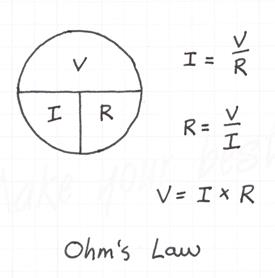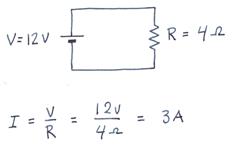
Figure 1.1
Named in honour of Georg Simon Ohm, Ohm's Law defines the relationship between current, voltage, and resistance.
Ohm's Law is one of the most foundational and most fundamental laws in electricity and electronics. It really paves the way for almost all of the formulas and circuit analysis that will follow.
Basically, it comes down to this: The current flowing through any component will be equal to the voltage across that component, divided by the resistance of that component.
It's a relationship that is as powerful as it is simple!
And, best of all, you can use it to find any missing value as long as you know the other two. Figure 1.1 shows a common memory aid used to remember Ohm's Law and how it works.
The letters represent Voltage (V), Current (I), and Resistance (R). I have added the three combinations to the right.
To use the memory aid, you simply cover up the quantity you're looking for. For example, if you cover up the "I", then you're left with V/R, and so on.
Current will equal the Voltage divided by the resistance.
Resistance will equal the Voltage divided by the current.
Voltage will equal the current times the resistance.
As you may be able to tell from the formula, it is impossible to change one of those quantities without affecting at least one of the other two.
Let's take a look at an example. Refer to Figure 1.2.

Figure 1.2
Here we have a simple circuit with a source, or battery, of 12 Volts and a load, or resistor, of 4 Ohms.
The missing value is the current (I), and therefore we can calculate this using Ohm's Law, and since we're looking for the current, we get the answer by dividing 12 Volts by 4 Ohms (V/R), and getting an answer of 3 Amps.
Notice that the formula works for all variations:
I = V / R ... 3A = 12V / 4Ω
R = V / I ... 4Ω = 12V / 3A
V = I x R ... 12V = 3A x 4Ω
That's a basic look at Ohm's Law, but we will return to it in future lessons.
